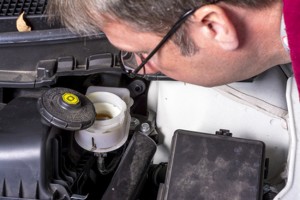 Over time, brake fluid deteriorates to the point that it will lose its effectiveness in the lines of the brake system components. Most automobile owners never realize that changing the brake fluid in their vehicles is just as important as changing the other fluids. The brakes of your automobile are the most important part of your safety on the roads and highways.
Over time, brake fluid deteriorates to the point that it will lose its effectiveness in the lines of the brake system components. Most automobile owners never realize that changing the brake fluid in their vehicles is just as important as changing the other fluids. The brakes of your automobile are the most important part of your safety on the roads and highways.
Avoid using old fluid because it can become contaminated with water, rust and dirt that will make your brake system wear out quicker. Always keep a close check on your brakes and the fluid reservoir to make sure that they are working correctly.
Brake Fluid Types
Most vehicles use either D.O.T. 3 or D.O.T. 4 brake fluid in the system. D.O.T. 5 brake fluid is a water repellant silicone based brake fluid that is popular also. Silicone doesn’t attract moisture like the other types, which give it a longer life over the other brake fluid types. Silicone is becoming more popular for use in newer models on the market today.
Brake Fluid Service Flush Cost and When to Change Fluid
Vehicle owners will pay a minimum of about 100.00 to have the brake fluid replaced in the system by a reputable dealer. It really depends on who services the vehicle, whether it is a local mechanic, auto dealership or independent shop on just how much you will have to pay.
Fluid replacement should be done every 24 months at the least. Some vehicle owners ask to have the fluid changed whenever they take their vehicles in for service to replace brake pads or rotors.
Changing the Fluid Yourself to Save Money
If you don’t mind getting your hands dirty changing the fluid at home is an easy procedure that will save you the cost of having to pay more at a shop. Have the necessary tools on hand before you attempt to do the job yourself. Always make sure that you replace the brake fluid with the correct type for your vehicles.
The tools you will need are a bag of shop towels, hydraulic floor jack to raise and lower the vehicle, wrench set to open and tighten the lines at each brake caliper and a helper.
After you raise the hood, remove the reservoir cap from the brake master cylinder. Use some sort of siphoning device to remove the fluid from the brake reservoir. It can be an ear cleaning syringe or anything similar that will siphon the old fluid from the reservoir.
Once this is done, raise the vehicle high enough at each wheel to open the brake lines with the correct wrench to allow the aged fluid to drain out of the lines. Place shop towels under the wheels to catch the old brake fluid runoff and leave all four lines open. Never press on the brake pedal inside the vehicle while the brake lines are opened at the brake cylinders. This reduces the chance of air entering the brake lines.
Open a new can of fluid and pour it into the reservoir allowing it to seep through the brake system lines until it is once again empty. This is called gravity bleeding. You will know that the brake line system is completely clean by following this procedure. The shop towels will soak up any fluid spilled under each brake caliper.
Add more fluid to the reservoir while tightening all brake lines at each brake cylinder. Top off new brake fluid to the reservoir at the proper level and replace the cap. Check the brakes by pressing the brake pedal to make sure air isn’t in the brake lines. You will know air is present in the lines if the brake pedal feels spongy or travels all the way to the floor.
To correct this and remove any air from the line, have the helper press the brake pedal several times and hold it tightly to the floor as you open each brake line just enough allowing the air to escape. Repeat this process for brake calipers at each wheel.
Once this is done, new fluid is in the brake lines, and no air will be present. Add more fluid to the reservoir to the proper level and clean up afterwards. This process involves more work when you do it yourself at home, but it saves money.
Whenever you are working with the brake system on any vehicle, always use recommended fluids and parts for that particular model. Take the necessary time needed to do a thorough job making safety the key issue before and after the work is completed.
